
A crucial area of unease for many dental practices revolves roughly around dental codes and their capacity to correctly code, using the correct dental procedure code, which is critical, and at times confusing.
To practice revenue, many dental offices outsource dental billing services like various code sets CDT and CPT for claim submission.
CDT Codes
The American Dental Association updates the CDT code set for adjunctive services and procedural codes like oral health to a great extent provided in the industry. The CDT code set consists of alphanumeric classification starting with the letter D for the procedure code followed with the four numbers.
Dentists use CDT codes for dental procedures in claim submissions to insurers. The CDT code set brings specificity in documenting the treatment accurately in the electronic health record. The codes get revised annually by the AMA.
The code set categorizes codes based on services like:
CPT codes
CPT codes are medical procedures codes maintained by the American Dental Association. CPT codes are level 1 codes for all submitted claims to insurance companies.
When to allocate CDT & when to allocate CPT Dental Codes?
It's often confusing when to allocate CPT codes and CDT codes. Typically, this depends on the kind of insurance to which the claim will be reimbursed.
Insurers have three kinds of coverage for billing:
How do dental practices submit using CDT dental codes?
To allocate dental insurance codes from the CDT, the patient must hold dental insurance. If the patient does not carry dental insurance, their coverage will not reimburse for any procedures conducted. Usually, patients assume their medical insurance will also fund dental procedures.
Therefore, it is necessary to pay attention to the kind of coverage each patient holds.
Let’s look at a few examples of dental procedures that get billed to medical insurance:
The compatible medical code with the intended dental code gets identified as cross-referencing like I & D of abscess- intraoral soft tissue D7510/ 41800 & Alveoloplasty w/extractions per quadrant D7310/ 41874.
CDT codes can work with the diagnostic codes ICD-10, such as K00 to K95. The associated disease is the digestive illness that includes mouth diseases treated by a dentist.
Using the correct CDT or CPT code set ensures that everything complies with appropriate and timely reimbursement.